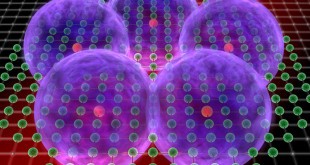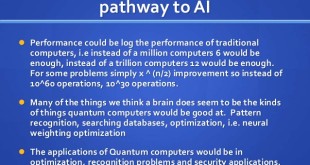The extraordinary promise of quantum technology—depend on quantum “entanglement,” in which the physical states of two or more objects such as atoms, photons or ions become so inextricably connected that the state of one particle can instantly influence the state of the other—no matter how far apart they are. Today, entanglement is actively being explored as a resource for future technologies including quantum computers, quantum communication networks and high-precision quantum sensors. Entanglement takes place when a part of particles interacts physically. For instance, a laser beam fired through a certain type of crystal can cause individual light particles to be split into pairs of entangled photons.
Some of the new quantum technologies ranging from extremely precise sensors to universal quantum computers require a large number of quantum bits in order to exploit the advantages of quantum physics. Physicists all over the world are therefore working on implementing entangled systems with more quantum bits.
The record is currently held by Rainer Blatt’s research group at the Institute of Experimental Physics at the University of Innsbruck. In 2011, the physicists entangled 14 individually addressable quantum bits for the first time and thus realized the largest completely entangled quantum register.
A quantum register is a system comprising multiple qubits and is the quantum analog of the classical processor register. First, there’s a conceptual difference between the quantum and classical register. An n size classical register refers to an array of n flip flops. An n size quantum register is merely a collection of n qubits.
Moreover, while an n size classical register is able to store a single value of the 2^{n} possibilities spanned by n classical pure bits, a quantum register is able to store all 2^{n} possibilities spanned by quantum pure qubits in the same time.
Now, a research team led by Ben Lanyon and Rainer Blatt have built a 20-bit quantum register, a system of 20 qubits whose quantum states can be individually controlled. In this experiment, 20 charged calcium atoms, or ions, arranged in a line served as the qubits, and they were entangled using a series of lasers.
The team were able to get the calcium ions to entangle with two, three, or occasionally even four other calcium ions in the system. This isn’t the first time so many particles have been entangled – but what’s exciting is that the team were able to individually read and address each of the qubits.
“There are quantum systems such as ultra-cold gases in which entanglement between a large number of particles has been detected,” said lead author Nicolai Friis, a physicist at the Austrian Academy of Sciences in Vienna. There are also early stage quantum computers out there that argue more qubits – such as IBM’s 50-qubit machine and Google’s 72-qubit Bristlecone. But in these cases, the individual quantum states of the qubits aren’t controllable, and nor can the system read out the individual qubits.
To overcome this, the team used an ion trap to confine the calcium ions using a magnetic field. Then they used lasers to entangle the ions, creating a 20-qubit system, with each qubit encoded into the electronic state of a trapped atomic ion.
However, an entangled system involving multiple particles can’t be described as individual particles, but only as a whole entangled multi-particle system.This makes detection difficult – so the team had to devise a custom means of detecting multi-particle entanglement.
“The particles are first entangled in pairs,” explained senior author Ben Lanyon from the Austrian Academy of Sciences. His team worked alongside researchers at the University of Ulm in Germany.
It is therefore suitable for practical applications such as quantum simulations or quantum information processing. Rainer Blatt and his team hope to increase the number of quantum bits in the experiment. “Our medium-term goal is 50 particles,” he says. “This could help us solve problems that the best supercomputers today still fail to accomplish.”
The methods developed for the ion trap experiment in Innsbruck will be used more widely, the physicists in Ulm and Vienna are convinced. “We want to push the boundaries of our methods even further,” say Friis and Marty. “By exploiting symmetries and focusing on certain observables, we can further optimize these methods to detect even more extensive multi-particle entanglement.
SQUARE Team Studies Light-Activated Materials for Building Quantum Registers
In an initiative called the Scalable Rare Earth Ion Quantum Computing Nodes (SQUARE) project, researchers at Karlsruhe Institute of Technology (KIT) are investigating materials — specifically, rare-earth ions — to be used for multifunctional quantum bits (qubits). Rare-earth ions are electrically charged atoms of rare-earth metals, and they have the potential to support the quantum properties that will be required for computation processes to be executed in parallel.
SQUARE, which is funded by the European Commission, is aimed at establishing which rare-earth ions can be used as basic building blocks for scalable quantum technologies. In particular, the SQUARE project team plans to demonstrate functional elements of a multiqubit quantum register that can be read out optically and to realize the building blocks of a quantum network. In cooperation with industry partners, the SQUARE team will develop central technological components required for scalable implementation.
Rare-earth ions can store quantum states for a very long time and can be activated separately by light in special solid-state crystals. For these reasons, a large number of ions are accessible as qubits. “Thanks to their special electronic structure, rare-earth ions are shielded against interference fields,” said professor David Hunger. “Moreover, they can strongly interact with each other, which is a major basis for quantum circuits.” Research relating to single rare-earth ions still is in an early stage, but “the project concentrates on a highly promising platform that offers many advantages over established approaches, such as ions captured in vacuum devices and superconducting quantum circuits,” Hunger said.
References and Resources also include:
https://phys.org/news/2018-04-quantum-physicists-entanglement.html
https://www.sciencealert.com/quantum-computing-broken-20-qubit-quantum-register
https://www.photonics.com/Articles/SQUARE_Team_Will_Study_Rare_Earth_Ions_for/a64118
 International Defense Security & Technology Your trusted Source for News, Research and Analysis
International Defense Security & Technology Your trusted Source for News, Research and Analysis

